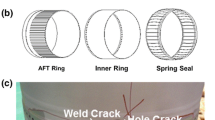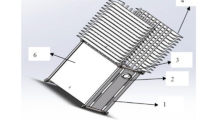Abstract
The liner of an internal combustion engine is subjected to a high temperature of combustion gas, which leads to high thermal stresses. In the present study, the thermomechanical analysis of a cylindrical liner was carried out to estimate the temperature profile and stress distribution. For thermal analysis, the input values of combustion gas temperature and its heat transfer coefficient were obtained by carrying out 1D thermodynamic cycle simulation using AVL BOOST® software. The temperature of the liner reduces from TDC to BDC. The temperature distribution of the liner was obtained by conjugate heat transfer analysis using ANSYS Fluent®. This temperature distribution was used for stress analysis of the liner using ANSYS®. The stress and deformation become maximum at an intermediate point near TDC. Near TDC, the gas pressure is more, but it acts on a smaller surface, as the piston goes towards BDC pressure force reduces and the surface area on which it acts increases gradually.
Access provided by Autonomous University of Puebla. Download conference paper PDF
Similar content being viewed by others
Keywords
3.1 Introduction
The reliability and performance of an internal combustion engine are limited by the maximum temperature of its components. Thermal loading of the engine components is increasing because of its increased output. This, in turn, causes higher thermal stress on the components. Hence, the temperature distribution and evaluation of stress on engine components, e.g. piston, liner, cylinder head, are important parameters for engine durability. Work has been carried out by various researchers to determine the temperature of the engine components, and various materials have been used to control their temperature and stress.
Heat transfer model to predict the transient operation of the turbocharged diesel engine was developed. This model included correlations for the convective heat transfer coefficient of a different part of the engine [1]. The piston was analysed by considering the lubricating oil film, the secondary motion of piston and piston ring. The boundary conditions for numerical simulation were verified with experimental results and were used to predict the temperature distribution of a newly developed engine [2]. The performance of the diesel engine was studied by using various materials of the liner. The aim was to select suitable material in order to minimize the heat loss through the cylinder wall. Low thermal conductivity materials with the required mechanical properties were considered for this purpose [3]. The effects of three types of coating, viz. ceramic (PSZ), Al2O3 and nickel chrome, on the liner were compared in terms of thermal stress, heat flux, thermal gradient and nodal temperature. The analysis was done numerically by ANSYS software. Al2O3 was found to be the best in this respect [4]. Finite element analysis is very helpful for the thermomechanical analysis of the liner, as it is difficult to analyse the actual working condition. This helps in designing the component with more durability [5].
Considering the previous research work, it can be concluded that the thermomechanical analysis of the liner is very important to ensure the proper operation of the engine. Hence, the aim of the present paper is to study the temperature distribution of a liner of a 600 hp engine and stress developed in the liner at full load condition rated speed (3300 rpm).
3.2 Methodology
CAD model of the liner analysed in the present study is shown in Fig. 3.1. The liner is surrounded by coolant passage with one inlet and two outlets. The geometric model was created using Creo Elements/Pro (Pro/ENGINEER) software and was transferred to ANSYS Fluent® software to carry out CFD study. The temperature distribution was obtained from this study, and the obtained distribution was used to carry out a stress analysis.
3.2.1 CFD Study
During the CFD study, steady-state conjugate heat transfer analysis was carried out to analyse conduction through the liner and convection of coolant together. For carrying out the analysis, the heat transfer coefficients and temperatures of combustion gas at the various positions of the piston in the liner are required. They were obtained (at an interval of 20° rotation of crank angle) at full load condition from the thermodynamic simulation by AVL BOOST® software. As the analysis was carried out in the steady state, the heat transfer coefficients and temperatures of combustion gas at the various positions of the liner needed to be averaged. During this averaging, data for all positions of the piston (0–720°) were used.
The liner is not subjected to the same combustion gas temperature and heat transfer coefficient from TDC to BDC. Hence, it was divided into nine segments (Fig. 3.2). The height of each segment corresponds to the height traversed by the piston during 20° crankshaft rotation (e.g. the distance covered during 0–20° crankshaft rotation represented the height of the first segment from TDC, and the distance covered during 160–180° crankshaft rotation represented the height of the segment just before BDC). Depending on the movement of the piston, each segment is subjected to different combustion gas temperatures and heat transfer coefficients. Crankcase temperature and heat transfer coefficient were applied to the portion below BDC. During the averaging procedure, it was assumed that, at any stage, the segments above and below the piston are at combustion temperature and heat transfer coefficient and at crankcase temperature and heat transfer coefficient, respectively.
Finally, the temperature and heat transfer coefficient of each segment were averaged as follows.
The coolant flow rate around the liner was considered to be 52 lpm. The velocity inlet was applied to the coolant inlet and pressure outlet was applied to the coolant outlet. The averaged temperatures and heat transfer coefficients were applied to each segment of the inner side of the liner. The coolant inlet temperature was assumed to be 118 °C.
The model used for the analysis was SST k-ω. This model takes advantage of both k-ω and k-ε models. It uses the k-ω method near the wall and k-ε method away from the wall.
3.2.2 Stress Analysis
The temperature distribution was obtained by CFD analysis. Subsequently, the resultant temperature and heat transfer coefficient were used for stress analysis of the liner (Fig. 3.3). During stress analysis, the coolant domain was suppressed. Fixed boundary condition in the radial direction was applied to the top rim of the piston (Fig. 3.4). The stress analysis of the liner was carried out for various positions of the piston. In the first case, the pressure was applied only in the topmost segment, as pressure due to combustion gas acts on this segment only. The value of applied pressure was equal to that of combustion gas during first 20° rotation of the crankshaft from TDC (obtained by AVL BOOST® software). By this analysis, the stress and deformation of the liner for this position of the piston were evaluated. In the next study, the pressure was applied only in the topmost and the next segment, as pressure due to combustion gas acts on this segment only. The pressure value equals the value during the first 20–40° rotation of the crankshaft from TDC (obtained by AVL BOOST® software). The process was continued for 9 cases (180° crankshaft rotation).
3.3 Results and Discussion
The temperature distribution, stress and deformation of the liner were obtained by CFD study (conjugate heat transfer analysis) and stress analysis.
3.3.1 CFD Study
The temperature distribution was obtained by CFD study (conjugate heat transfer analysis) and is shown in Fig. 3.5. It shows that the temperature of the inner side of the liner decreases gradually from top to bottom. It can be explained by considering the fact that the upper portion of the liner remains exposed to combustion gas to a more extent. The time for exposure to combustion gas reduces gradually from top to bottom.
3.3.2 Stress Analysis
Stress analysis was carried out for 9 positions of the piston in the liner during the power stroke (at a 20° interval from TDC to BDC). Equivalent stress (von Mises stress), shear stress and total deformation were evaluated at each position. It was observed that at each position of the piston, stress and deformation at a different location of the liner follow a similar pattern (maximum and minimum values occur at the similar places in all cases). Stress and deformation pattern for the two extreme cases (at TDC and BDC of the piston in the liner) are shown in Fig. 3.6. In all conditions, stress reduces from top to bottom and deflection increases from top to bottom. It can be explained by considering the fact that pressure and displacement constrained are applied only in the top position.
The maximum values of stresses and deformation of the liner at each position of the piston are shown in Fig. 3.7. It is seen that the maximum value takes place at some intermediate position of the piston. It can be explained by considering the fact that the gas pressure is the maximum when the piston is at TDC, but it acts on the minimum surface area. The value of pressure starts to decrease as the piston moves down, but the area exposed to pressure starts to increase simultaneously. Hence, the effect of pressure becomes the maximum at some intermediate position. The value of stress and deformation changes accordingly.
3.4 Conclusion
The temperature of the liner decreases from top to bottom. Stress and deformation of the liner at different positions follow the same pattern during all positions of the piston (maximum and minimum values occur at the similar places in all cases). Both maximum stress and deformation become maximum at some intermediate position of the piston. In all positions, the stress values reduce from top to bottom as the displacement was arrested at the top rim of the liner and deflection gradually increases from top to bottom.
References
Galindo, J., Lujan, J.M., Serrano, J.R., Dolz, V., Guilain, S.: Description of a heat transfer model suitable to calculate transient processes of turbocharged diesel engines with one-dimensional gas-dynamic codes. Appl. Therm. Eng. 26, 66–76 (2006)
Lu, X., Li, Q., Zhang, W., Guo, Y., He, T., Zou, D.: Thermal analysis on piston of marine diesel engine. Appl. Therm. Eng. 50, 168–176 (2013)
Dineshkumar, S., Sriprashanth, V.: IC engine wet liners thermal analysis. Int. J. Eng. Sci. Res. Technol. 4, 489–496 (2015)
Anand Kumar, M., Prasad Rao, A.A.V., Hari Narayana Rao, J.: Design and analysis of dry cylinder liners used in diesel engines. Int. J. Sci. Eng. Adv. 3, 518–526 (2015)
Shinde, S., Jadhav, P.V., Jadhav, D.B.: Thermo mechanical analysis of cylinder liner. Int. J. Eng. Res. General Sci. 4(3), 296–306 (2016)
Author information
Authors and Affiliations
Corresponding author
Editor information
Editors and Affiliations
Rights and permissions
Copyright information
© 2020 Springer Nature Singapore Pte Ltd.
About this paper
Cite this paper
Roy, S., Ganesh, N., Kumarasamy, A., Viswanathan, P. (2020). Thermomechanical Analysis of a Cylindrical Liner. In: Li, C., Chandrasekhar, U., Onwubolu, G. (eds) Advances in Engineering Design and Simulation. Lecture Notes on Multidisciplinary Industrial Engineering. Springer, Singapore. https://doi.org/10.1007/978-981-13-8468-4_3
Download citation
DOI: https://doi.org/10.1007/978-981-13-8468-4_3
Published:
Publisher Name: Springer, Singapore
Print ISBN: 978-981-13-8467-7
Online ISBN: 978-981-13-8468-4
eBook Packages: EngineeringEngineering (R0)











